2000 SUBARU FORESTER weight
[x] Cancel search: weightPage 5 of 322
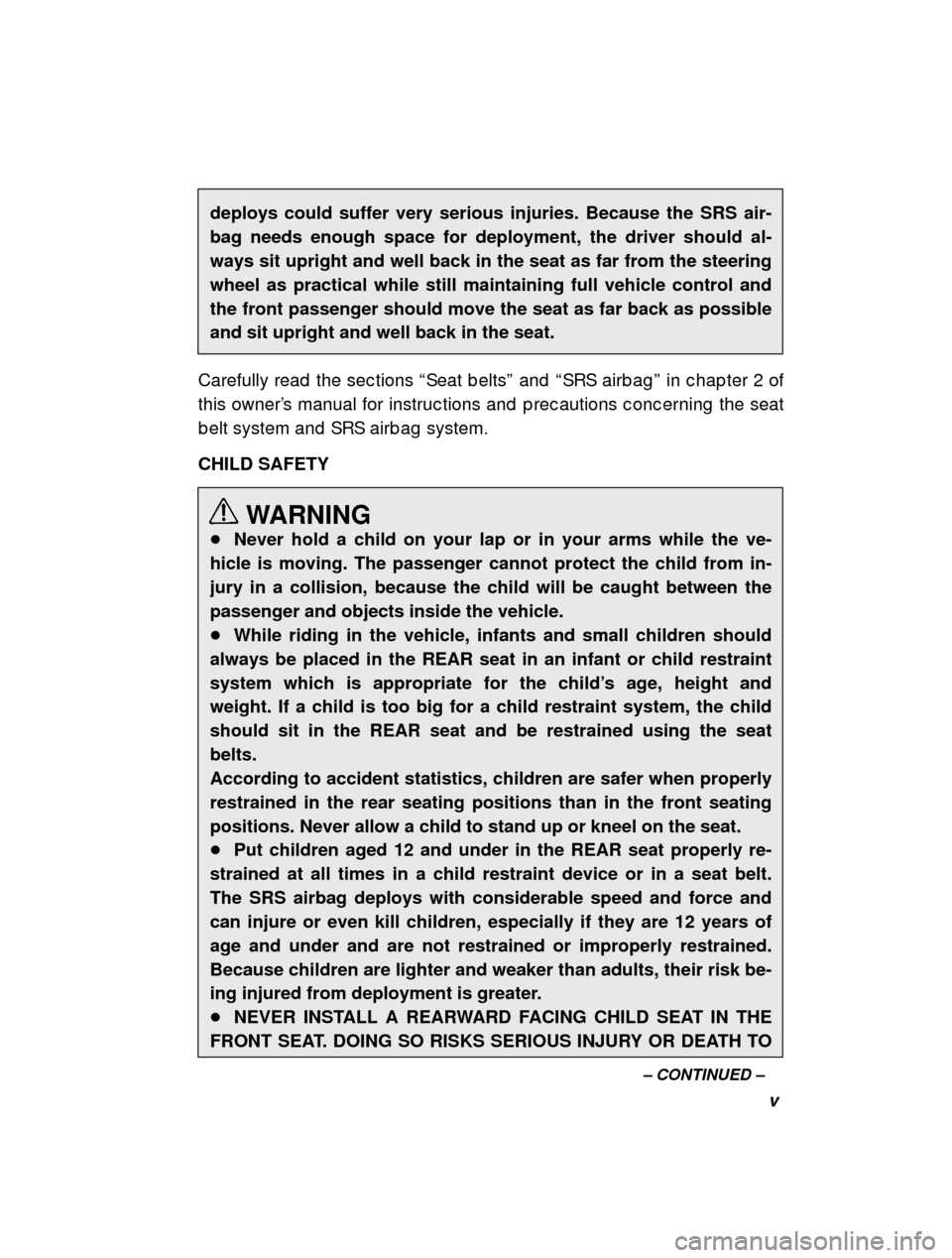
v
–
CONTINUED –
deploys could suffer very serious injuries. Because the SRS air- bag needs enough space for deployment, the driver should al-ways sit upright and well back in the seat as far from the steeringwheel as practical while still maintaining full vehicle control and
the front passenger should move the seat as far back as possibleand sit upright and well back in the seat.
Carefully read the sec tions “Seat b elts ” and “SRS airb ag ” in c hap ter 2 of
this owner ’s manual for instruc tions and p rec autions c onc ernin g the seat
b elt system and SRS airb ag system. CHILD SAFETY
WARNING
� Never hold a child on your lap or in your arms while the ve-
hicle is moving. The passenger cannot protect the child from in- jury in a collision, because the child will be caught between the
passenger and objects inside the vehicle.� While riding in the vehicle, infants and small children should
always be placed in the REAR seat in an infant or child restraint
system which is appropriate for the child ’s age, height and
weight. If a child is too big for a child restraint system, the childshould sit in the REAR seat and be restrained using the seatbelts.According to accident statistics, children are safer when properlyrestrained in the rear seating positions than in the front seatingpositions. Never allow a child to stand up or kneel on the seat.� Put children aged 12 and under in the REAR seat properly re-
strained at all times in a child restraint device or in a seat belt.The SRS airbag deploys with considerable speed and force andcan injure or even kill children, especially if they are 12 years ofage and under and are not restrained or improperly restrained.
Because children are lighter and weaker than adults, their risk be-
ing injured from deployment is greater.� NEVER INSTALL A REARWARD FACING CHILD SEAT IN THE
FRONT SEAT. DOING SO RISKS SERIOUS INJURY OR DEATH TO
Page 48 of 322

Doors and locks1-29
–
CONTINUED –
To c lose the hood :
1. Lift the hood slig htly and remove the hood p rop f
rom the slot in the
hood and return the p rop to its retainer.
2. Lower the hood until it ap p roac hes ab out 6 in. (1 5 c m) from the
c losed p osition and let it d rop .
3. After c losing the hood , b e sure the hood is sec ur ely loc ked .
If this d oes not c lose the hood , release it from a slig htly hig her p osition.
Do not p ush the hood forc ib ly to c lose it. It c ould d eform the metal.
Roof rail and crossbar (if equipped)
CAUTION
� For cargo carrying purposes, the roof rail must be used to-
gether with a roof cross bar kit. The roof rail must never be used
alone to carry cargo. Otherwise, damage to the roof or paint or adangerous road hazard due to loss of cargo could result.� When using the roof cross bar kit, make sure that the total
weight of the crossbars, carrying attachment and cargo does not
exceed the maximum load limit. Overloading may cause damageto the vehicle and create a safety hazard.
HS1005BB
The roof rail is not d esig ned to c arry c arg o b y its elf.
Carg o c an b e c arried on the roof after sec uring the roof c ross b ar kit to
Page 49 of 322

1-30the roof rail. When installing the roof c ross b ar k
it on the roof rail, follow
the manufac turer ’s instruc tions. When you c arry c arg o on the roof us ing
the roof c ross b ar kit, never exc eed maximum load l imit exp lained b elow.
You should also b e c areful that your vehic le d oes n ot exc eed the Gross
Vehic le Weig ht Rating (GVWR) and front and rear Gro ss Axle Weig ht Rat-
ing (GAWR). See the “Load ing your vehic le ” sec tion in c hap ter 7 for in-
formation on load ing c arg o into or onto your vehic l e.
� When luggage is put on the slats (Vehicles with roof slats only)
When p utting any lug g ag e on the slats, make sure th e total weig ht of the
lug g ag e on the slats of the roof c ross b ar kit d oes not exc eed 100 lb. (45
kg) . Overload ing may c ause d amag e to the roof and c rea te a safety haz-
ard . Plac e the heaviest load at the b ottom, nearest the roof, and evenly
d istrib ute the lug g ag e. Always sec ure the lug g ag e w ith strap s, rop es or
nets. � Installing carrying attachments on the cross bars
When installing any c arrying attac hment suc h as a b ike c arrier, ski c arri-
er, kayak c arrier, etc . on the c ross b ars, follow t he manufac turer’s instruc -
tions and make sure that the attac hment is sec urely fixed to the c ross
b ars. Use only attac hments d esig ned sp ec ific ally fo r the c rossb ars. A
set of the c ross b ars is d esig ned to c arry load s (c arg o and attac hment)
of not more than 150 lb. (68 kg). Before op erating the vehic le, make sure
that the c arg o is p rop erly sec ured on the attac hmen t.
NOTE Remember that the vehicle ’s center of gravity is altered with the
weight of the load on the roof, thus affecting driving characteristics.
Drive carefully. Avoid rapid starts, hard cornering and abrupt stops.Crosswind effects will be increased.
Page 55 of 322
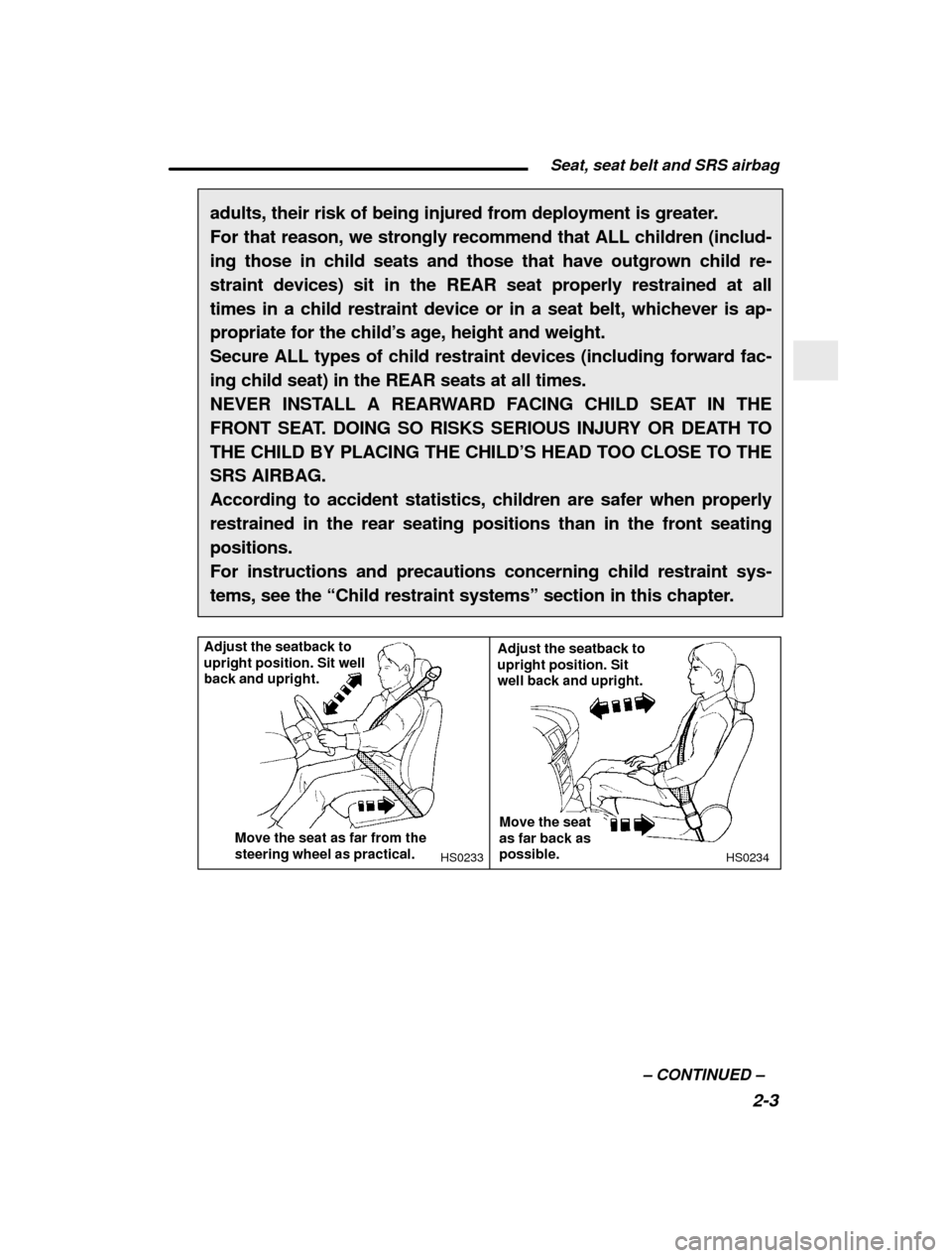
Seat, seat belt and SRS airbag2-3
–
CONTINUED –
adults, their risk of being injured from deployment is greater.
For that reason, we strongly recommend that ALL children (includ-
ing those in child seats and those that have outgrown child re-
straint devices) sit in the REAR seat properly restrained at all
times in a child restraint device or in a seat belt, whichever is ap-
propriate for the child
’s age, height and weight.
Secure ALL types of child restraint devices (including forward fac-
ing child seat) in the REAR seats at all times.
NEVER INSTALL A REARWARD FACING CHILD SEAT IN THE
FRONT SEAT. DOING SO RISKS SERIOUS INJURY OR DEATH TO
THE CHILD BY PLACING THE CHILD ’S HEAD TOO CLOSE TO THE
SRS AIRBAG.
According to accident statistics, children are safer when properly
restrained in the rear seating positions than in the front seatingpositions.
For instructions and precautions concerning child restraint sys-
tems, see the “Child restraint systems ” section in this chapter.
HS0234
HS0233
Adjust the seatback to upright position. Sit well back and upright.
Move the seat as far from the steering wheel as practical. Adjust the seatback toupright position. Sit well back and upright.Move the seat as far back as possible.
Page 64 of 322
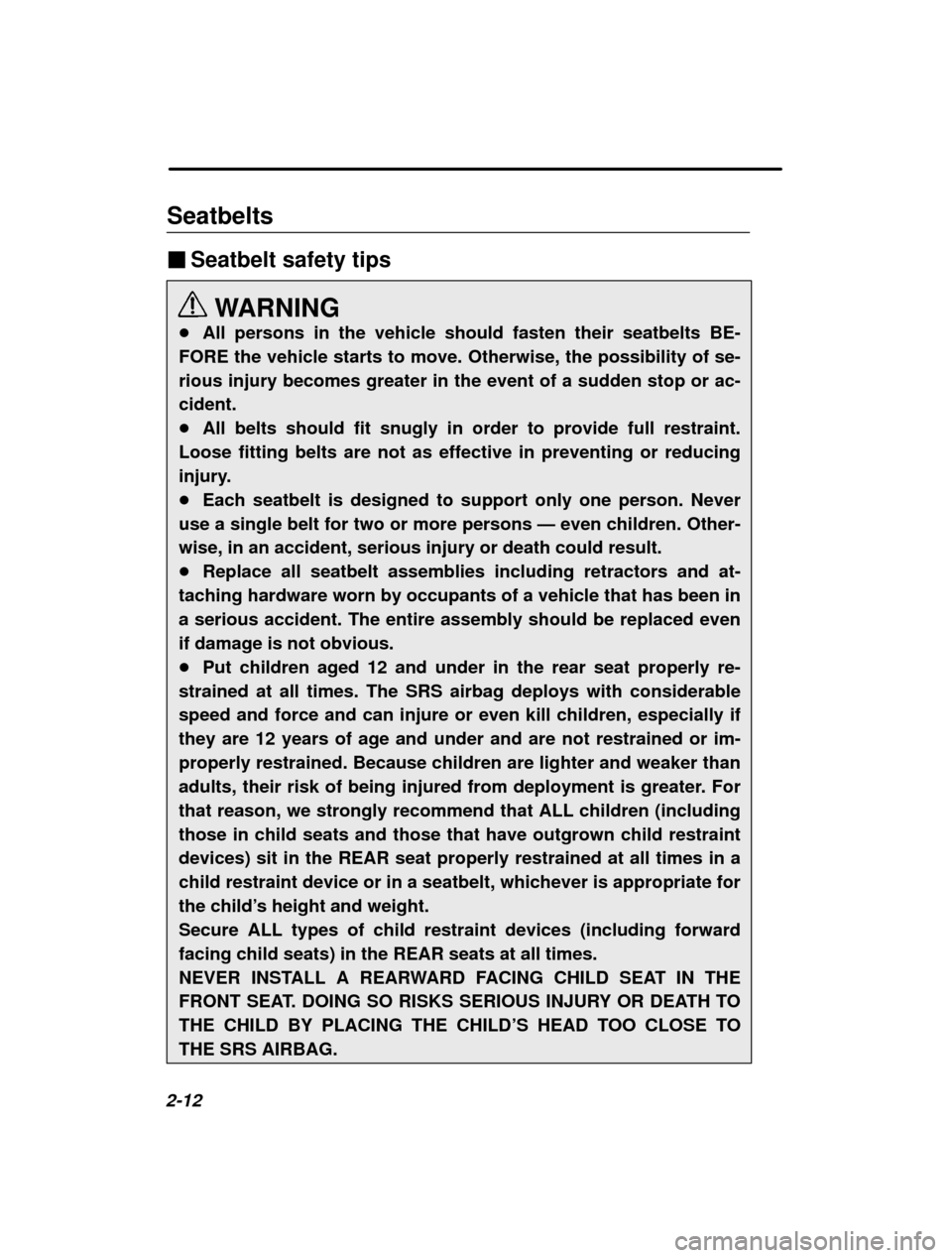
2-12Seatbelts �
Seatbelt safety tips
WARNING
� All persons in the vehicle should fasten their seatbelts BE-
FORE the vehicle starts to move. Otherwise, the possibility of se-
rious injury becomes greater in the event of a sudden stop or ac-cident.� All belts should fit snugly in order to provide full restraint.
Loose fitting belts are not as effective in preventing or reducing
injury.� Each seatbelt is designed to support only one person. Never
use a single belt for two or more persons — even children. Other-
wise, in an accident, serious injury or death could result.� Replace all seatbelt assemblies including retractors and at-
taching hardware worn by occupants of a vehicle that has been ina serious accident. The entire assembly should be replaced evenif damage is not obvious.� Put children aged 12 and under in the rear seat properly re-
strained at all times. The SRS airbag deploys with considerablespeed and force and can injure or even kill children, especially ifthey are 12 years of age and under and are not restrained or im-properly restrained. Because children are lighter and weaker than
adults, their risk of being injured from deployment is greater. Forthat reason, we strongly recommend that ALL children (includingthose in child seats and those that have outgrown child restraint
devices) sit in the REAR seat properly restrained at all times in achild restraint device or in a seatbelt, whichever is appropriate forthe child ’s height and weight.
Secure ALL types of child restraint devices (including forwardfacing child seats) in the REAR seats at all times.
NEVER INSTALL A REARWARD FACING CHILD SEAT IN THE
FRONT SEAT. DOING SO RISKS SERIOUS INJURY OR DEATH TOTHE CHILD BY PLACING THE CHILD ’S HEAD TOO CLOSE TO
THE SRS AIRBAG.
Page 73 of 322
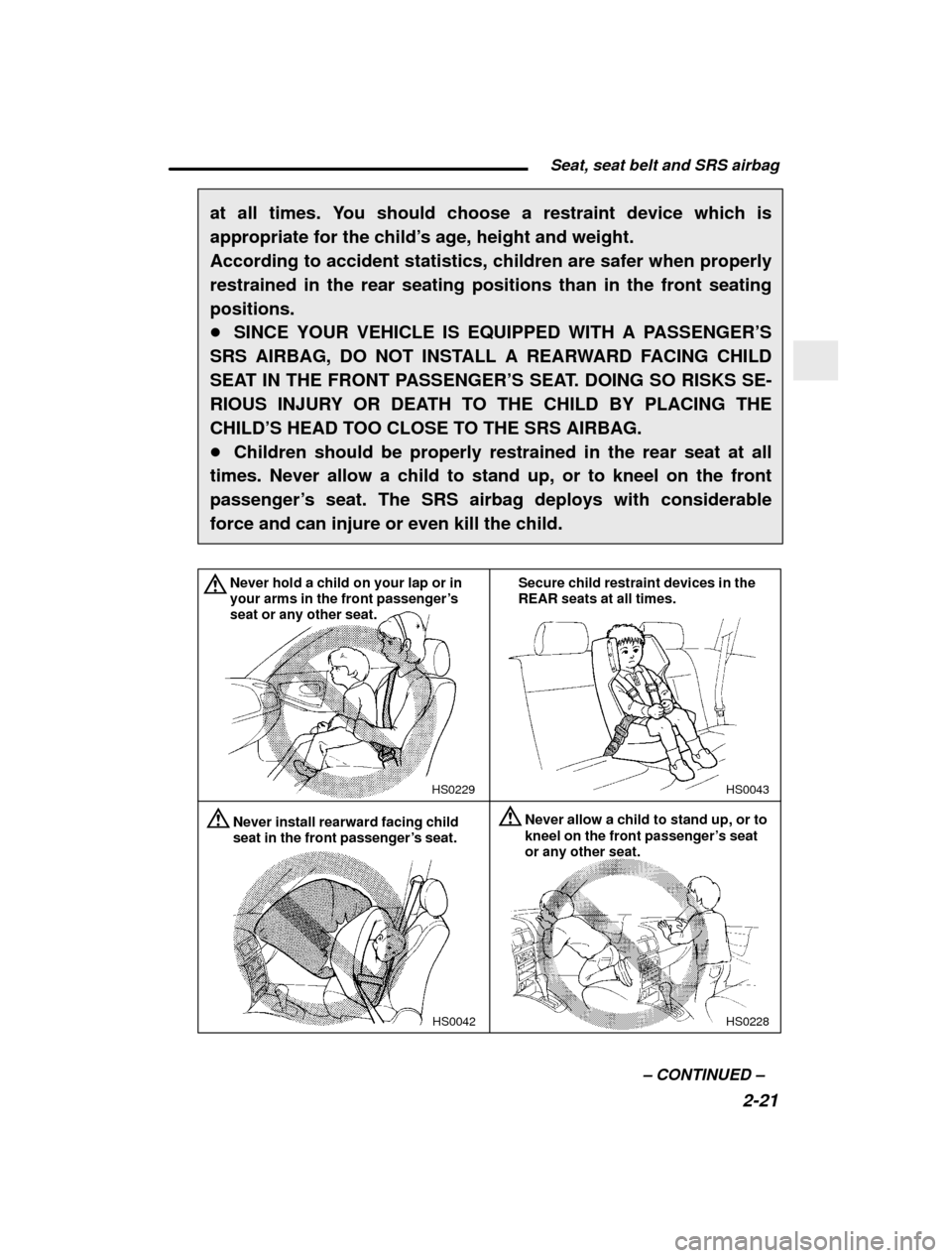
Seat, seat belt and SRS airbag2-21
–
CONTINUED –
at all times. You should choose a restraint device which is appropriate for the child
’s age, height and weight.
According to accident statistics, children are safer when properlyrestrained in the rear seating positions than in the front seatingpositions.� SINCE YOUR VEHICLE IS EQUIPPED WITH A PASSENGER ’S
SRS AIRBAG, DO NOT INSTALL A REARWARD FACING CHILD
SEAT IN THE FRONT PASSENGER ’S SEAT. DOING SO RISKS SE-
RIOUS INJURY OR DEATH TO THE CHILD BY PLACING THE
CHILD’ S HEAD TOO CLOSE TO THE SRS AIRBAG.
� Children should be properly restrained in the rear seat at all
times. Never allow a child to stand up, or to kneel on the front
passenger’ s seat. The SRS airbag deploys with considerable
force and can injure or even kill the child.
HS0043
HS0229
HS0228
HS0042
Never allow a child to stand up, or to kneel on the front passenger ’s seat
or any other seat.
Never hold a child on your lap or in your arms in the front passenger ’s
seat or any other seat.
Never install rearward facing child seat in the front passenger ’s seat.
Secure child restraint devices in the REAR seats at all times.
Page 81 of 322
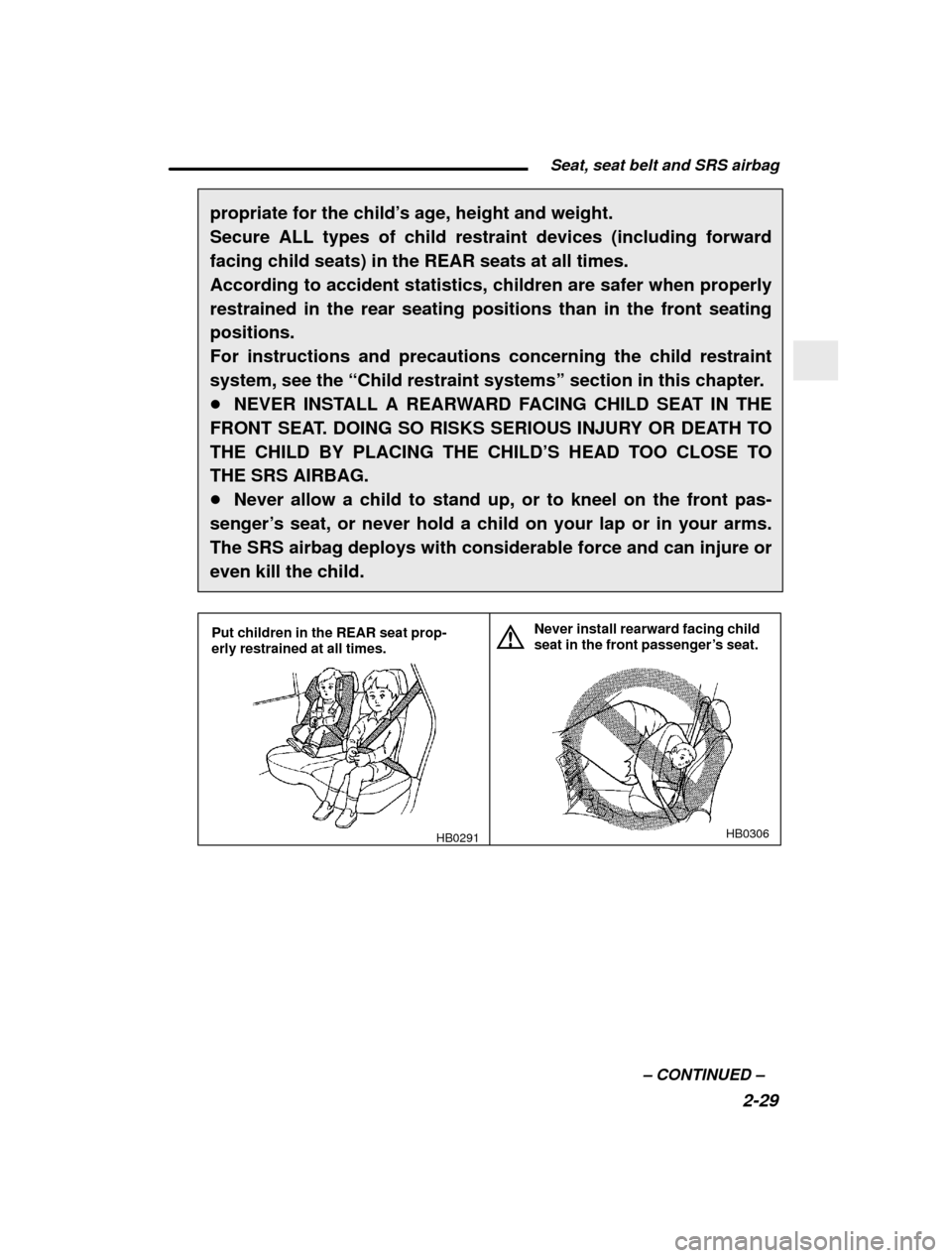
Seat, seat belt and SRS airbag2-29
–
CONTINUED –
propriate for the child
’s age, height and weight.
Secure ALL types of child restraint devices (including forward facing child seats) in the REAR seats at all times.According to accident statistics, children are safer when properlyrestrained in the rear seating positions than in the front seatingpositions.For instructions and precautions concerning the child restraint
system, see the “Child restraint systems ” section in this chapter.
� NEVER INSTALL A REARWARD FACING CHILD SEAT IN THE
FRONT SEAT. DOING SO RISKS SERIOUS INJURY OR DEATH TOTHE CHILD BY PLACING THE CHILD ’S HEAD TOO CLOSE TO
THE SRS AIRBAG.� Never allow a child to stand up, or to kneel on the front pas-
senger’ s seat, or never hold a child on your lap or in your arms.
The SRS airbag deploys with considerable force and can injure oreven kill the child.
HB0306
HB0291
Put children in the REAR seat prop- erly restrained at all times.
Never install rearward facing child seat in the front passenger
’s seat.
Page 167 of 322

Interior equipment6-23
–
CONTINUED –
Coat hook
CAUTION
Never hang anything on the coat hook that might obstruct the
driver’ s view or that could cause injury in sudden stops or in a
collision. And do not hang items on the coat hook that weight 1kg (2.2 lb) or more.
The c oat hook is attac hed to the rear p asseng er ’s hand g rip b ehind the
d river.
HS0109
Interior light
HS6003BB
HS0110